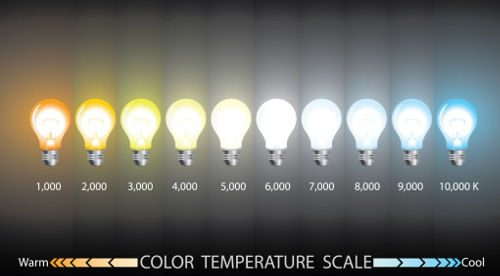Sometimes the problem is not in having not enough light but with too much light as well.
In this article, we will answer and cover these topics:
- How many lumens do you need for a desk lamp
- Differences between lumens and watts
- Type of light-bulbs
- Other interesting and useful features to know about light
So, how many lumens do you need for your desk lamp to optimally perform tasks?
In short, it all depends on the purpose of the lamp in question.
For general purposes like reading and writing, it would be around 450 lumens.
For more delicate tasks like looking at small parts because you are a repairman or doing some heavy-duty drafting, it would be a minimum of 800, but we mostly recommend about 1100 lumens.
Note! As you age, the more light you will need. For example, if you are under 55, you would generally need around 450 lumens. If you are age 55 and above, you need 800 lumens, almost double as before.
Lumens, or lm for short, are a measurement of the brightness of the light. The more lumen light has, the brighter it will appear.
Lumens are, in a sense, a new way to actually measure the light output of the bulb, which is more accurate than the previous measurement – watt.
Sometimes you may see and hear about another measurement that is called Lux or lx for short. Lux isn’t essential for you and your desk lamp unless you are in the photo and video business industry.
For all of you who love doing DIY projects, you can create your very own desk lamp by following our simple guide.
Understanding Correlations Between Watts And Lumens
Watt indicates how much energy is needed (cost of energy) to produce the light. This has been the standard method of household thinking regarding how much lighting is required.
So, how many watts do you need for a desk lamp?
For general purposes, 40 watts is enough. It is equivalent to 450 lumens stated above.
For more delicate tasks, 60 to 75 watts is sufficient. It is equivalent to 800 to 1100 lumens, respectively.
Note! There is no accurate official conversion method from watts to lumens. When we speak of equivalent, that is a good approximation and can vary across multiple manufacturers.
Types Of Light-Bulbs And Why Is It Important To Properly Choose One
Light bulbs are two centuries old today, so it’s normal to expect that they have evolved into many different shapes and sizes. Although most people aren’t aware of that fact, we will show you the different types of bulbs and show you their advantages and disadvantages.
Here is the list of the most common types of light bulbs for your desk surroundings:
Looney lumens is reader-supported and participates in the Amazon Associates Program. When you buy a product through links on our site, we may earn a small commission, at no extra cost to you.
Incandescent Bulb
Incandescent bulbs are the classic ones and were standard in households and in various buildings up until the late 1990s.
They work as an electric process as the current passes through a tungsten wire filament, and it starts to glow. They are cheap and affordable, have a nice cozy warm light, and they are easily disposable.
However, they are not energy efficient since most of the energy is transformed into heat. Also, they only last about 700 to 1000 hours of use.
Pros
- Cheap Cost
- Nice Warm Light
- Dimmable
Cons
- Least Energy Efficient
- Shortest Lifespan
- Fragile
Halogen Bulb
Halogen bulbs are similar to incandescent ones but with one crucial difference that makes them a better choice.
They have a chemical process that prevents the degradation of the wire filament. The secret is in the insertion of a small amount of Halogen with an inert gas. That same gas increases the brightness levels and performance and extends the bulb’s lifespan of about 2500-3000 hours of use.
Another great thing about halogen bulbs is that they are smaller in size as compared to incandescent ones.
Pros
- High Brightness
- Nice Warm Light
- Dimmable
Cons
- Little Energy Savings
- Little More Expensive
- Short Lifespan
Compact Fluorescent (CFL)
The compact fluorescent lighting is almost the same as its smaller counterpart above. It also uses mercury and differs mostly by its shape, which consists of multiple tubular loops and resembles the incandescent bulb type. Mostly anyways.
It also produces the same amount of light with much less energy and power and has a longer lifespan from 7000 to 10.000 hours of use. Again, you need to carefully dispose of them because of mercury.
Pros
- Low Cost
- Longer Lifespan
- Cool White Light
- More Energy Efficient
Cons
- Contains Mercury
- Not Dimmable
- Long Warm-up Time
- Fragile
Light Emitting Diode (LED)
LEDs are becoming the standard norm for bulbs around the world. They are conquering the task lighting industry, including desk lamps and similar lamps, and becoming more popular.
LEDs are semiconductor devices that emit light from the negatively charged diode when struck by electric energy. They are very energy efficient and can produce much brighter light and various lighting colors as well with less energy.
These bulbs have a considerable lifespan of over 50.000 hours of use, which is mind-blowing compared with previous incandescent bulbs of 1000 hours of use.
It is also worth mentioning that the LED lights weaken over time, meaning that they don’t emit as much brightness as before.
Pros
- Most Energy Efficient
- Produces Little Heat
- Cool Performance White Light
- Longest Lifespan
- Many Light Color Options
- Easy Disposal
Cons
- High Cost
- Not All Are Dimmable
- Light Weakens Over Time
Other Important Features Of Light To Consider
Other exciting features and light abilities can be useful to know if you want to have the best possible light from your desk lamp. So if you are curious, then read on.
Color Temperature

Not every light is created equal. Color temperature is the ability of light to appear in different colors, thus affecting the surrounding ambient.
The light can be warmer or cooler in appearance. Its unit is measured in Kelvin or K for short. The higher the K, the whiter, and bluish the light will appear.
Why is this important?
As stated before, the light temperature affects the surrounding areas, including you and your moods. It can also increase performance if you work with the correct color temperature.
Note! Even though higher levels of K seem to increase the overall brightness of the bulb, it’s not true. The same light output remains no matter the levels of the color temperature.
There are three types of light color coming from bulbs:
Warm Light (2700K to 3000K)
A soft warmish yellow light that creates a soothing and relaxing feel. It is a good choice for home offices and for areas such as dining rooms, living rooms, and bedrooms.
Bright Cool White (3500K – 4100K)
This light is a bit whiter than the previous lights, and it is a good choice for lighting up workspaces and areas such as bathrooms, kitchens, and outdoor lighting.
Daylight (5000K – 6500K)
It is a bluish and whitish light. It resembles noon on a day without clouds. A good choice for working on various projects that requires focus on small details and similar activities.
Color Rendering Index (CRI)

CRI is the ability of light to reveal the true colors of an illuminating object. It is measured on a scale from 0 to 100– the higher the CRI, the higher color accuracy. Only natural light has the highest index of 100.
Why is this important?
If you can’t see an object’s true colors, you can’t expect to work properly. This is truer if you work with small parts.
Having a low CRI light source can trick your eyes into believing that you are working on one color when it’s a totally different one.
Most LED lights have an 80 or more index value, so we recommend going with that.
SUMMARY
- How many lumens you need depends on the tasks that you will be doing – the more demanding task, the more light you will need.
- The older you get, the more light you will need also.
- Besides lumens, you also need to know other vital light attributes, such as color temperature and color rendering index. These factors can influence your productivity.
- There are many types of light bulbs, each with its advantages and disadvantages. We always recommend going with LED bulbs, and thanks to the broad market, you can choose many different desk lamps that will fit your needs and tastes.
Resource And References
- https://www.batteriesplus.com/blog/lighting/seeing-things-in-a-different-light
- https://www.lampsusa.com/blogs/buyers-guides/14015721-task-lighting-buyers-guide
- https://medium.com/@omegapacific/5-different-types-of-light-bulbs-32472c24bb70
- https://www.pooky.com/inspiration/all-about-lighting/how-to-choose-a-lightbulb-the-complete-guide
Other Useful Links
Author: Toni Segvic

Owner of the looneylumens.com website. A tech enthusiast and a marketer. Lover of lamps. Since I spend the better part of my days in front of the computer, I take my lamps very seriously. They impact my productivity and eyesight tremendously. My motto is: “Focus on the things that you can control. Leave the rest to God.”




